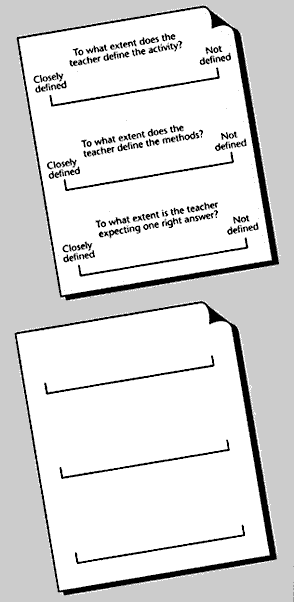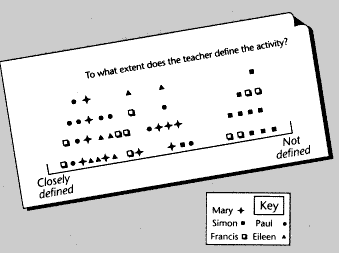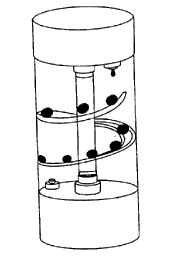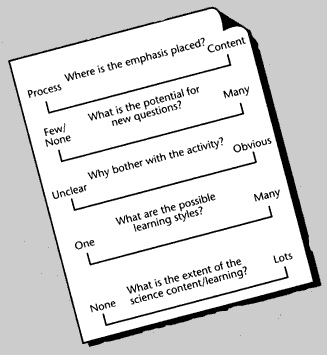 |




















|
 |
 |
|
author:
|
Sylvia Weir, Tim Barclay
|
|
description:
|
"Reflecting on practice: A tool for teacher change," published in Hands On!, 1994, discusses an
exercise developed and used by the authors to support and catalyze teachers' efforts to
change the ways in which they teach.
|
|
published in:
|
Hands On!, TERC
|
|
published:
|
1994
|
|
posted to site:
|
07/23/1998
|
Recognizing the importance of "learning by doing" has a long tradition in education. In our work at TERC, we don't just talk about science, we set up activities in which students "do" hands-on, preferably inquiry-based, science activities. Implementing this science in the classroom often requires a change in the way teachers teach. Therefore, understanding how to promote teacher change and how to provide appropriate support for teachers as they change their teaching practice should be part of implementing inquiry-based, hands-on science.
Changing one's behavior requires a self-conscious focus. Our habitual ways, by the very nature of being habits, can go on without our thinking about what we are doing. This tendency frees us to concentrate on other issues and questions, which is a real benefit. However, to break habitual patterns we need to spend time thinking about what we actually do. Typically, this is hard for teachers who have little time and few opportunities to think about or discuss their concerns. Any number of teachers could acknowledge the following comment that one teacher made during an interview.
When I talk with you, I think about things. This is great for me, because I don't get a chance to think about what I am doing and how it influences my students and how I feel, because no one asks me.... I've been teaching for 18 years and no one has wanted to listen.
In workshops at TERC we ask teachers to become learners and to experience for themselves the "doing" of science activities. Still, only doing is not enough. Customarily, we help facilitate teacher reflection after hands-on activities by using discussion groups and journal writing (see "Reflective Practice," Hands On! Fall 1992). Recently, however, we have come to supplement journal writing with another, more systematic process that has as its objective the "doing of reflection." Such an exercise can be thought of as a cognitive tool that is inwardly directed to help our thinking.
We have developed an exercise called Reflecting on Practice to support and catalyze teachers' efforts to change the ways in which they teach. Reflecting on Practice serves three specific functions: It is a way to facilitate more systematic teacher reflection, a way to deepen teachers' understanding of inquiry-based science, and a model for teachers to use in structuring the reflection of their students. The exercise consists of 4 a four-step process. (See also An Exercise for Reflecting on Practice, later in this article.)
In our teacher workshop we introduce Reflecting on Practice by using a set of descriptions written by five teachers to describe how they do inquiry-based science (see Figure 1)
- After participants read the teacher descriptions, they consider three questions (see Figure 2): To what extent does the teacher define the activity? To what extent does the teacher define the methods? To what extent is the teacher expecting one right answer? The participants respond to the questions by marking where they think the teacher descriptions should be placed on each continuum.
- After making their individual placements, participants come together in small groups to collate their placements in one composite picture (see Figure 3) and discuss the differences in their placements. At this point the true value of the experience can emerge, as individual placements are challenged, justified, and modified.
Reflecting on Practice is used again during the workshop.
- After participants carry out a variety of hands-on activities, Reflecting on Practice is applied to some of these as a tool for participants to think about what they have just done: How they went about their investigation and what they learned.
- As a wrap-up, participants write a report on how contextualizing reflection in this way helps them think about inquiry-based learning. What insights did they gain, if any, as they carried out the science activity? Did it provide a perspective for a change in attitude, or a deepening of understanding?
|
Description l: Mary
In their science work, I like to give my students the opportunity to select projects they find interesting within a particular topic. The main thing is building an interest in science. For example, while we were working through our human physiology unit, I prepared descriptions of possible experiments for my students to choose from. Halfway through the projects, we met as a class to discuss the range of discoveries they had made. I want to give them an opportunity to follow their own interests, and to have some choice in what they learn, because it is only when students are interested that they will really learn something.
Description 2: Paul
In my science class, I want my students to learn to think about what they are doing and why they are doing it. I start my class with a question; for example, do all seeds germinate in the same way? I allow plenty of time for class discussion for students to identify the factors involved, the controls needed, and so on, before they do the experiment. Discussions are important, because it is only when you hear students talk about what they are doing that you can tell whether they have really grasped the content. So that is why, after the experiment is completed, we end the class with a discussion.
Description 3: Simon
In my opinion, the important thing is the approach. Each semester, I have my students choose a science topic of interest to them. Each group plans an initial experiment and then I check their plan to make sure they are all safe and doable. After carrying out their initial exploration, students design a second one based on questions emerging from the first. You see, I don't really care whether my students learn the details of any content area. What I am most interested in is their learning science process skills and learning to work cooperatively in groups.
Description 4: Eileen
I am interested in having my students understand science as a social endeavor. For example, last month I presented my class with the question Does a car heat up more in the summer or the winter? They were instructed to discuss their ideas with members of their group. Groups then met for an all-class discussion and shared ideas. Together they generated a list of factors that might affect how much the car heats up. Each group chose one factor from the list to investigate. After testing their factors, the group shared their investigation designs and results. Then each group used the combined findings of all groups to design a prototype (on paper) for the best Heatkeeper.
Description 5: Francis
Project work is all about students being in charge and designing their own experiments. For example, the students develop questions related to our topic of study. They spend the next week exploring their questions. They come up with an initial plan for their chosen question, and present that plan to the class. The class votes on the best plan, and together we revise it. Only then, when the plan is agreed upon by all, when everyone is happy with the plan, only then do I work out an experiment that will answer the chosen question, and the students then carry it out. At the end of the experiment, we share results to make sure that everyone has arrived at the solution.
Figure 1. Teacher descriptions of inquiry-based science.
|

Figure 2. Labeled and blank continua |

Figure 3. Composites of placement on one continuum |
The Science of Reflecting
The dialogue with colleagues has been for me most exciting and really an "ah ha" experience. I never would have predicted that I would learn so much from another group's perspective. I loved discussing ideas and challenging mine and other perspectives on the work done. I did not feel competitive (which I bet is a problem in the real world) but felt like a real scientist searching for answers and open to new insights . . . I have loved this so much it makes me sick to think I never thought of myself as "scientific" because of a lack of exposure in grade school to any science. I believe I would have devoted my life to something different perhaps if I had been encouraged to ask why [and] then given the opportunity to find out.
--Journal entry of teacher attending a TERC workshop
At a local school in Cambridge, we have used Reflecting on Practice with the hands-on activity Watching the Drops (see Figure 4). After completing Steps 1 and 2 of the process, participants observed a desktop novelty, which is a small cylinder with opaque caps at each end. The drops cylinder is filled with a clear liquid, and when it is turned over, colored drops (blue or green, for instance) fall from the top cap, move along a spiral ramp inside the cylinder, and disappear into the bottom cap, only to drop again when the cylinder is turned over.
In this science activity, the participants worked in groups of four to six, each group having its own cylinder. The groups focused on generating questions about the activity as they watched the behavior of the drops.
The whole group talked about adding more continua and questions to the three listed in the introductory activity with the teacher descriptions. Five more questions were agreed upon (see Figure 5), and then the groups used Reflecting on Practice to help them think about the Watching the Drops activity.
Placements along the eight continua were typically very scattered, sometimes covering the whole spectrum from left to right. The groups explained their rationales for the ratings they made. Their explanations revealed their very different interpretations of the continua. After much discussion, the participants eliminated some of the differences and came to a more common understanding--at least they moved their placements to the same general region of the continua.
In those cases for which the differences were not reconciled, the groups retained their widely varying interpretations of the activity they had just completed. As is characteristic of newcomers to inquiry-based science, the groups needed to understand that continua are not scales for ranking bad to good. Unanimity is not the goal; provoking thought and further discussion is. For these participants, this goal was achieved.
As teachers sense the power of Reflecting on Practice, they apply it as a tool to gain insight to their own learning during the workshops and afterward. In fact, we as developers have experienced an interesting effect as we further refine the process for use at workshops--our own understanding of inquiry-based science continues to deepens.
As well as doing, we can think about what we are doing. As well as perceiving, we can reflect upon our experience. Piaget called this "reflective abstraction." Conscious self-reflection is slow to develop, and we mature as individuals to the extent that we can look at our own functioning.

Figure 4. Drops cylinder

Figure 5. Five continua added by workshop participants
An Exercise for Reflecting on Practice
For the workshop leader: Use the Reflecting on Practice process as a tool for teachers to examine their learning as they engage in inquiry based activities related to the content of the workshop. Focus on having participants exercise science process skills such as asking questions, making observations, and interpreting data. Schedule at least 1 1/2 to 2 hours for this exercise.
Materials needed
- Teacher descriptions sheet (see Figure 1)
- Labeled three-continua sheet (see Figure 2)
- Blank continua sheet (see Figure 2)
- Chart paper and markers
Preparation
- Make copies of the three sheets to distribute to participants.
- Draw the labeled three-continua on chart paper (to use when compiling teachers' placements).
Organization:
Break into small groups of three to five each. Introduce Reflecting on Practice and explain the representation using the three continua, pointing out that these are not meant to be value graded from bad to good. In the small groups, each participant should make placements for the five teacher descriptions on each of the continua before comparing placements and reaching consensus as a small group. This small group process is then repeated later for the whole group.
Discussion:
Have the small groups discuss their placements, especially the differences in their placements. Then repeat this step for the whole group. The following questions can be raised if they have not already been addressed by the participants.
- On which continuum is there the greatest range of placements?
- Are different placements based on different interpretations of the continuum question or different interpretations of the teacher descriptions?
- Can you articulate the rationales for differing placements of the same descriptions?
- Can you recap the discussion that caused you to change your placement?
- Do you think any given description should come in the same region on each of the continua?
Workshop Activities:
Emphasize that Reflecting on Practice is a tool, not an end in itself. As the workshop continues, have participants use this tool to reflect on their learning in carrying out activities. Suggested activities include Watching the Drops, microcomputer-based explorations, or any other investigations that employ science process skills.
Wrap-up:
Have participants record their thinking on and learning from the science activities. Encourage the participants to discuss their experiences with colleagues and to find ways to continue their reflecting on practice.
HINT
|
|
Include both structured activities and more open ones. In this way, participants can compare their learning when the instructions explain what to do and how to do it versus when they must assume more of the responsibility for posing questions
|
References
Simon, S.A., & Jones, A.T. (1992). Open work in science: A review of existing practice. OPENS Project, Centre of Educational Studies, King's College, University of London.
Weir, S. (1987). Cultivating minds. New York: Harper & Row.
Dr. Sylvia Weir worked as a developer and trainer on Hands-On Elementary Science. She is currently project director of Literacy in a Science Context.
Tim Barclay worked as a curriculum developer and workshop leader on Hands�On Elementary Science. He is currently project director of Hands-On Universe.
Reflecting on Practice was used in Hands-On Elementary Science workshops.
|
 |

